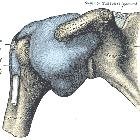Luxation der langen Bizepssehne






Dislocation of the long head of biceps tendon is one of the complications of shoulder injury. The long head of biceps (LHB) tendon is usually located inferiorly in the bicipital groove held there by the biceps pulley (the stabilization role of the transverse humeral ligament is controversial) . As it moves superiorly it arches through the rotator cuff interval where it is held by a sling formed by the superior glenohumeral ligament and the coracohumeral ligament.
When this ligament is deficient the tendon is free to dislocate medially. It is often associated with degenerative or traumatic tears of the rotator cuff, specifically tears of the subscapularis tendon.
If the tendon of the subscapularis is intact then the tendon is seen lying anterior to it. If, as is common, the subscapularis tendon is also deficient then the tendon of the long head of biceps can prolapse into the glenohumeral joint.
Radiographic features
MRI
Diagnosis is best made on axial MR images, where the bicipital groove is seen to be empty, and the tendon can be identified medially. If the tendon cannot be identified then a complete tear of the tendon should be sought.
Ultrasound
Non visualization of long head of biceps tendon in bicipital groove with medially displaced tendon.
Siehe auch:
und weiter:

 Assoziationen und Differentialdiagnosen zu Luxation der langen Bizepssehne:
Assoziationen und Differentialdiagnosen zu Luxation der langen Bizepssehne:
